Abstract
The effect of Friend virus on the response of Balb/c mice to sheep red cells, as measured by the numbers of haemolytic plaque forming cells in the spleen, was investigated. Virus injected with or before the antigen reduced the numbers of IgM and IgG antibody-producers, the latter more so than the former. Both the primary and the secondary responses were affected. Some possible mechanisms of action of the virus on immune responses are discussed.
Full text
PDF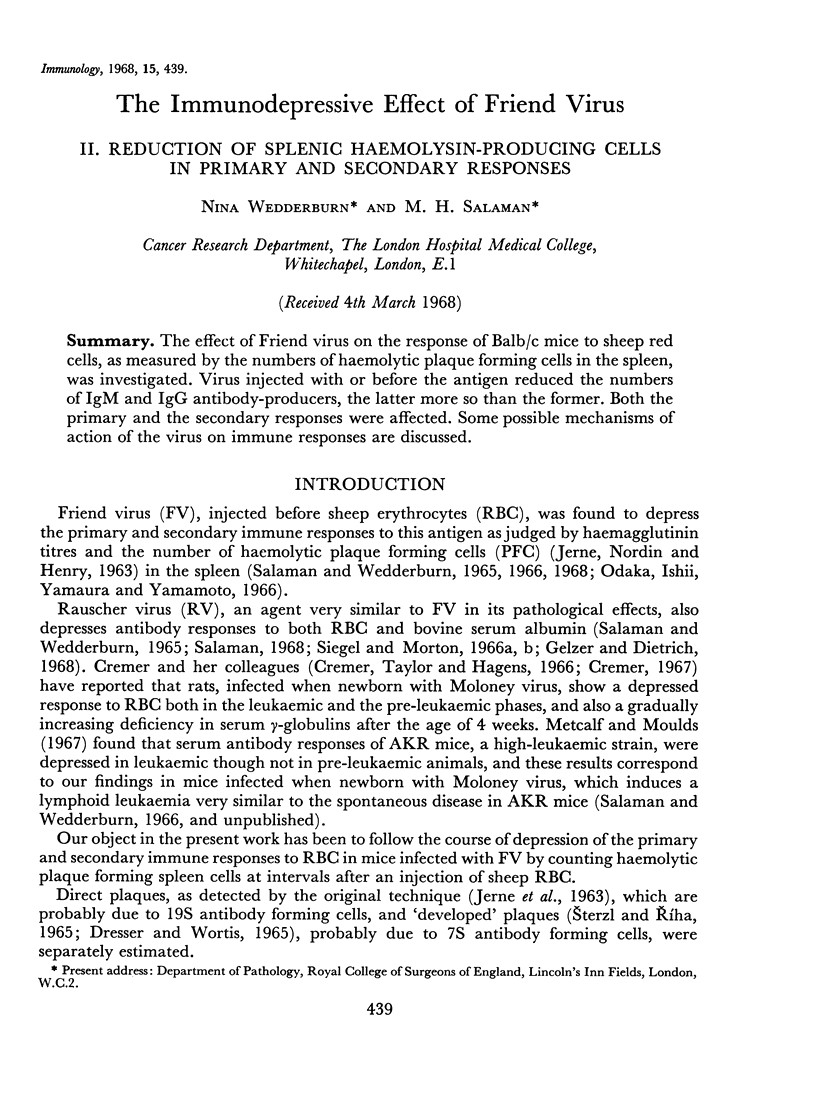
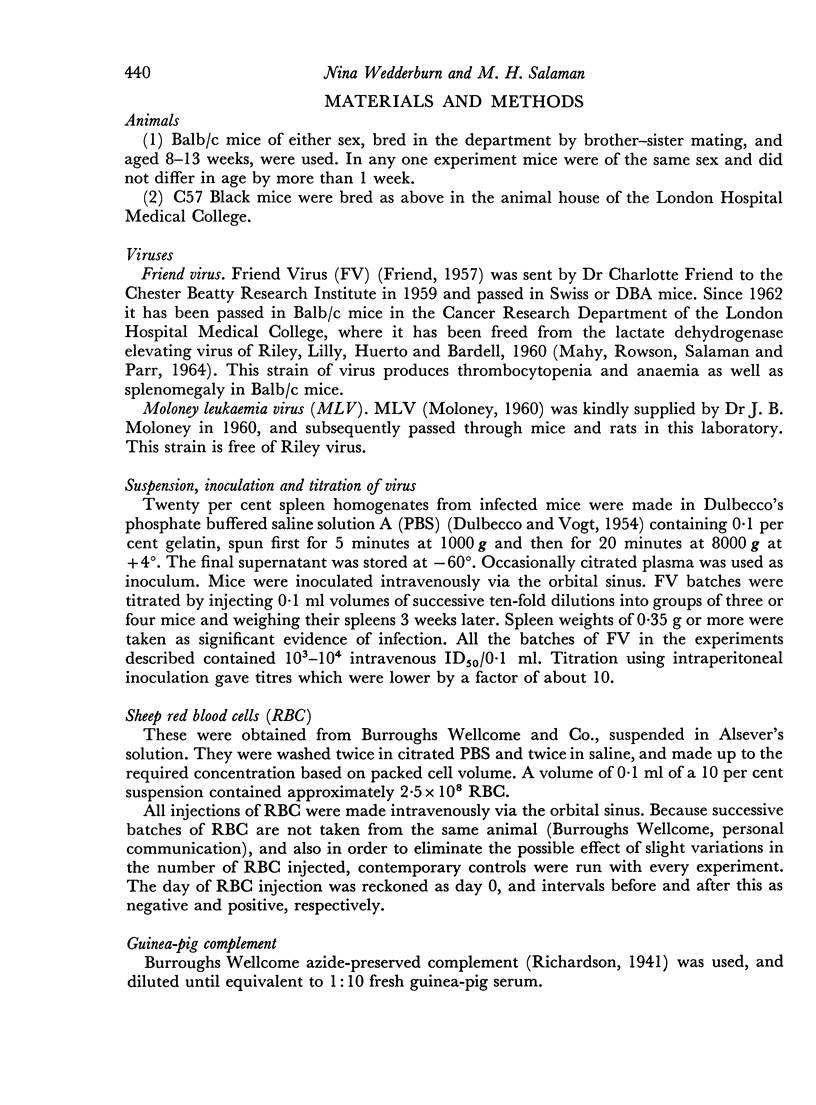
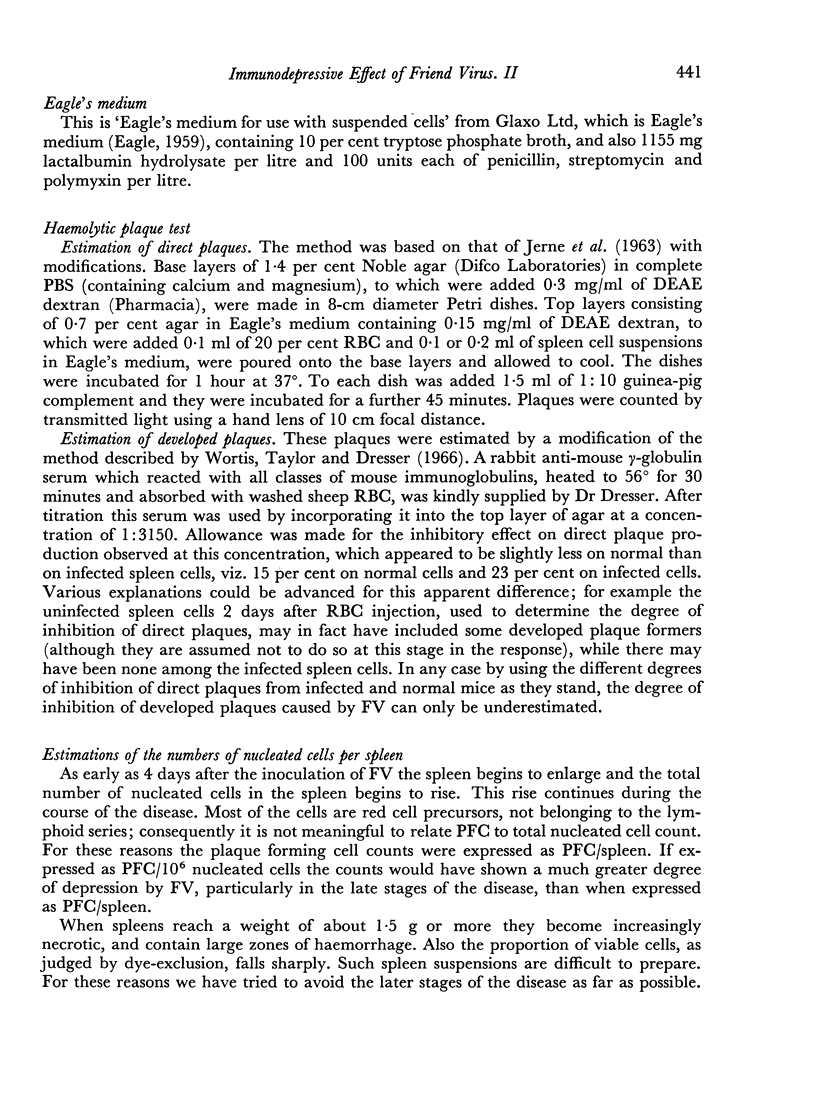
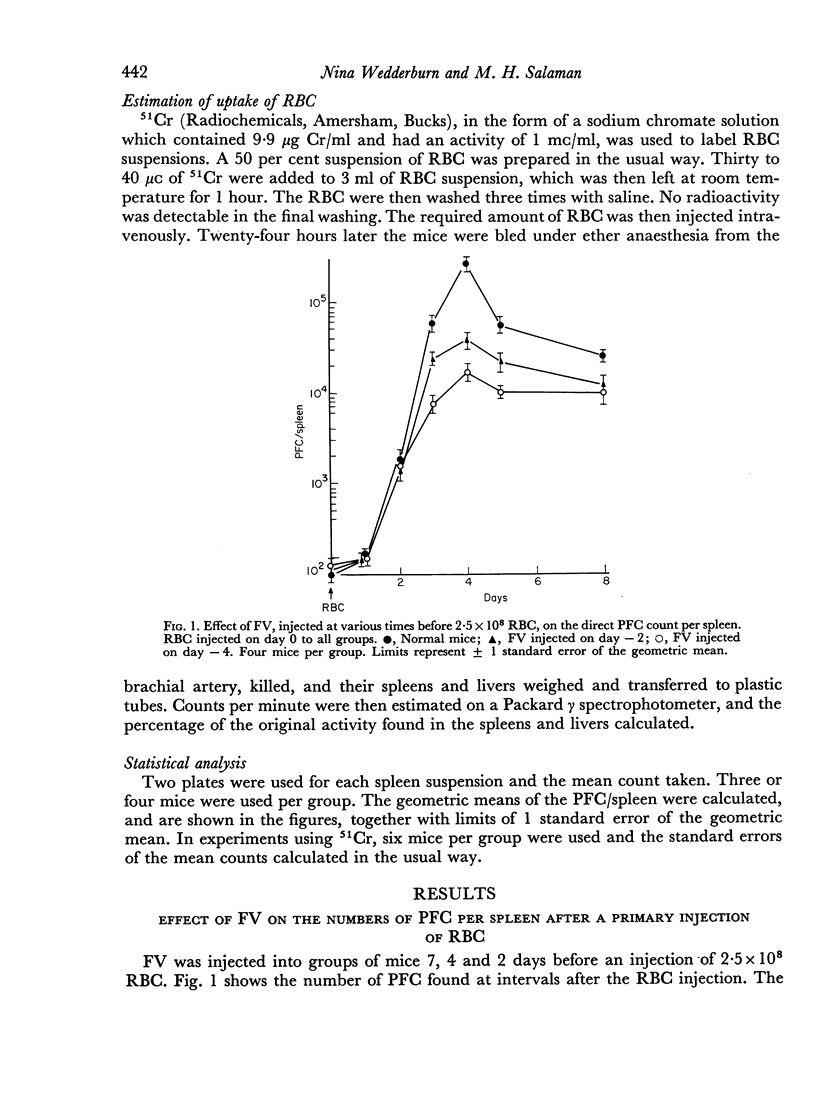
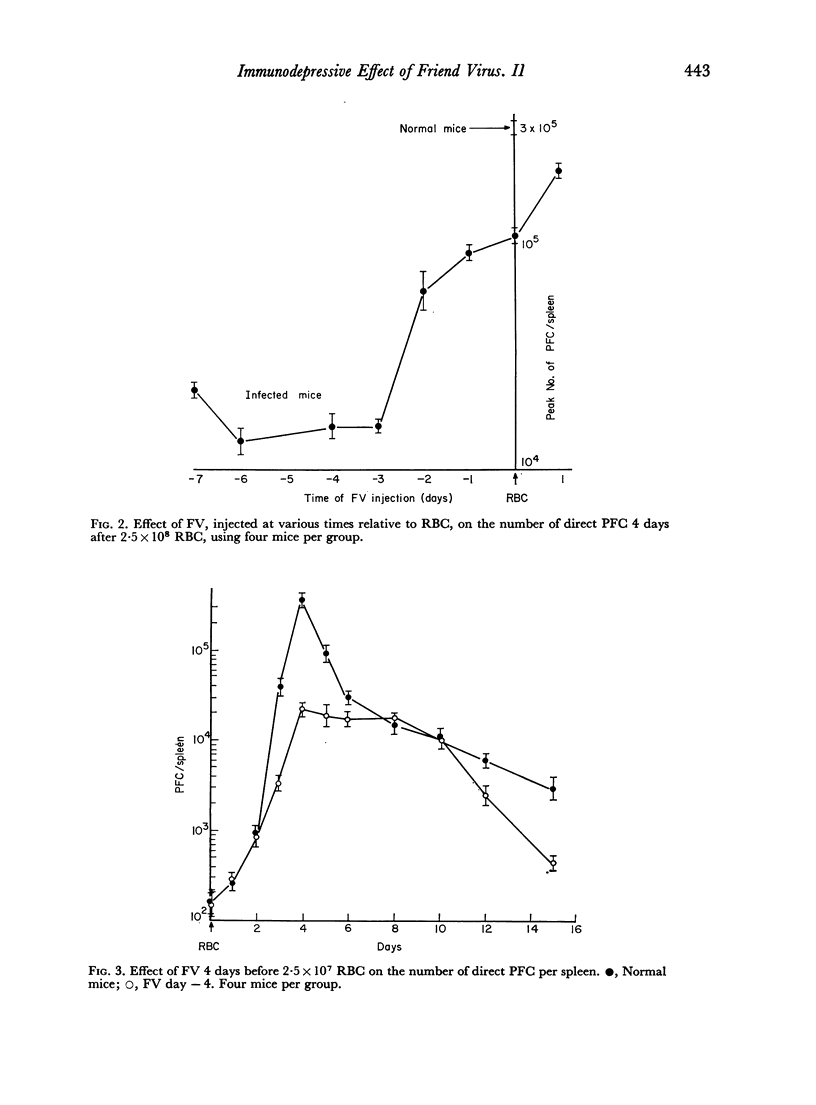
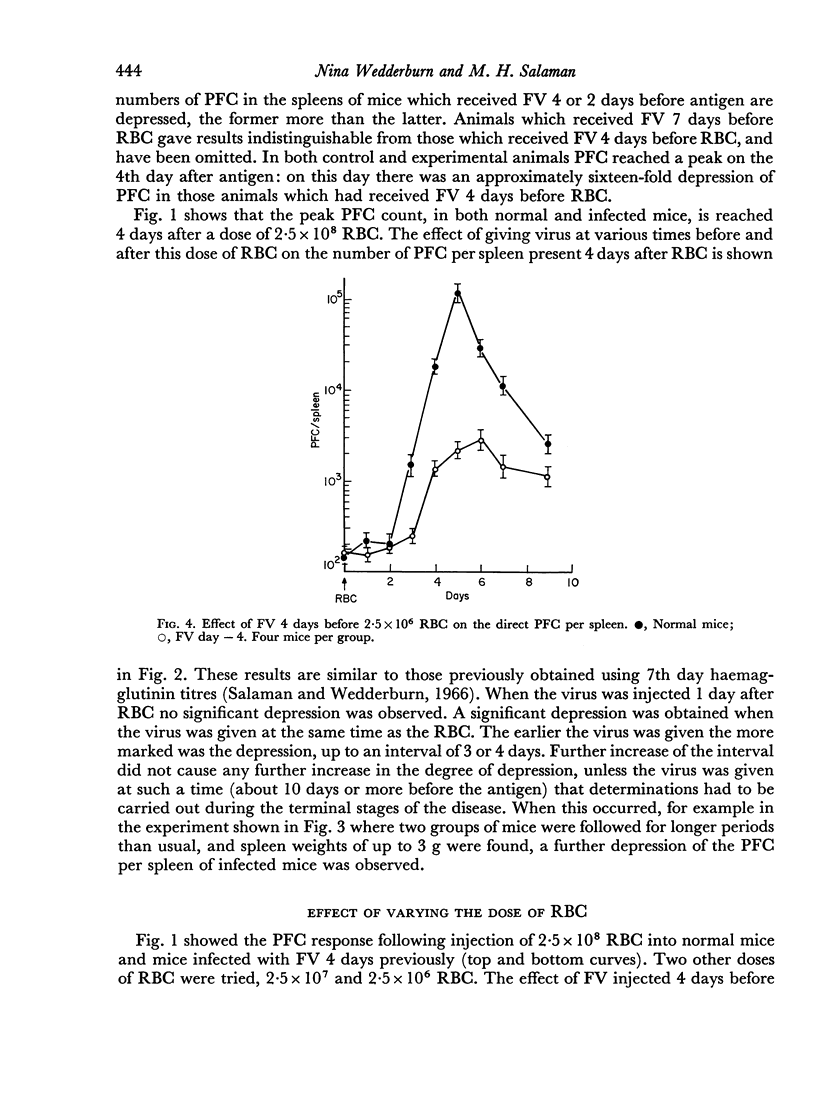
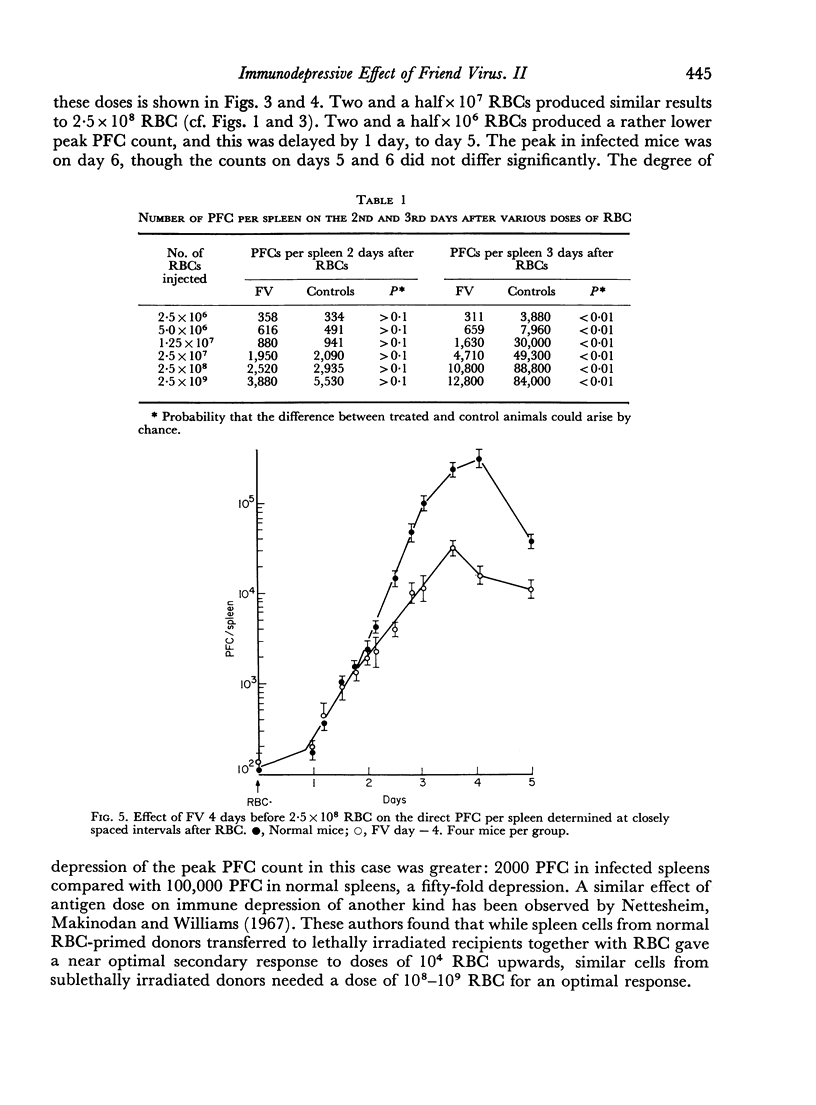
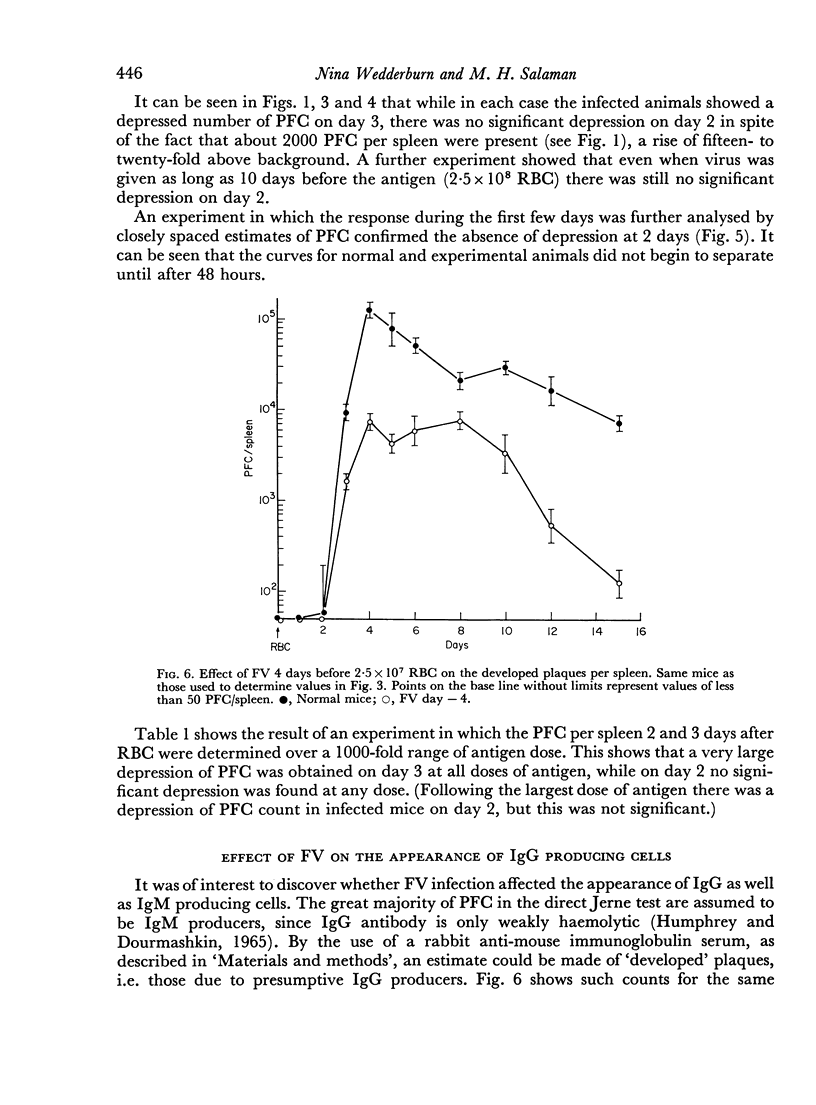
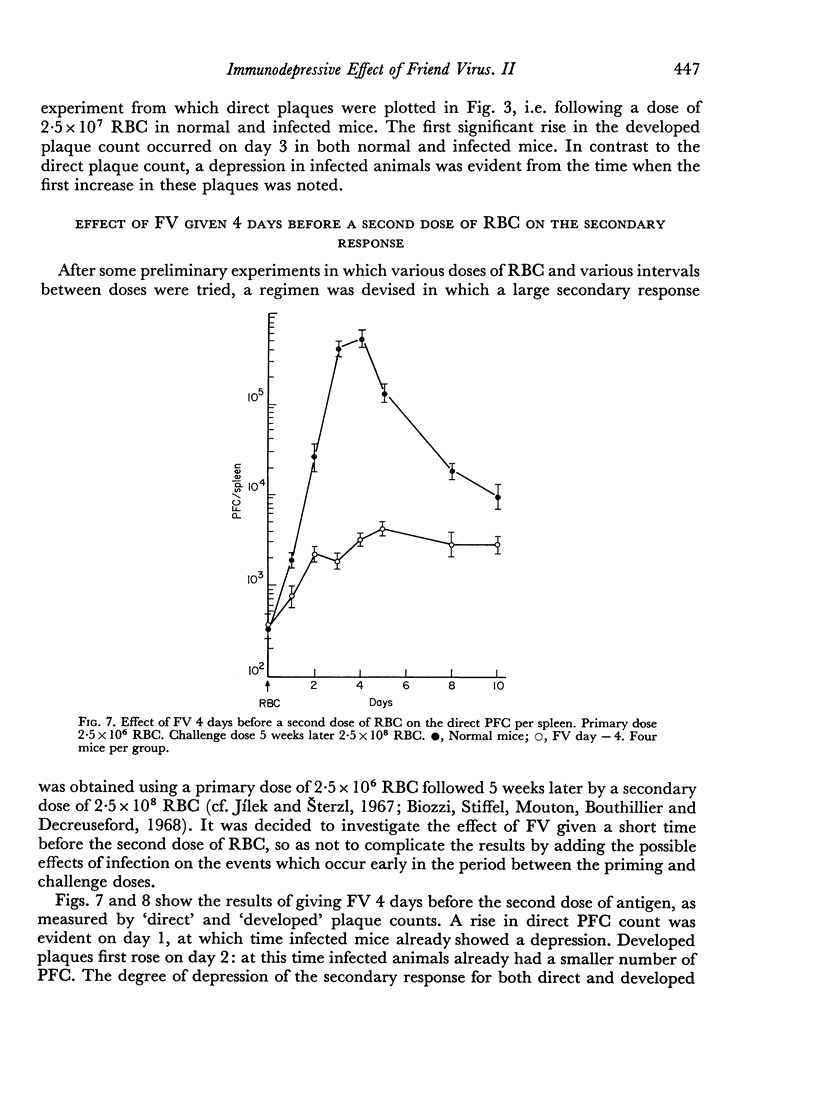

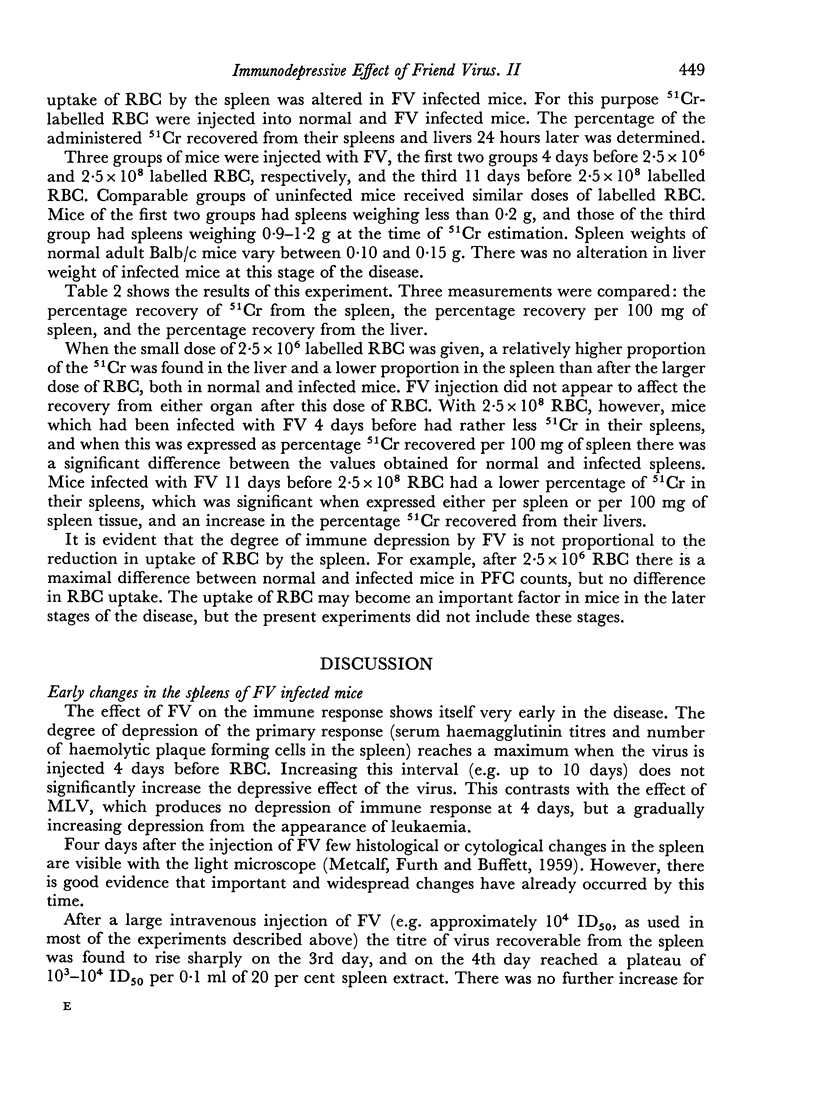
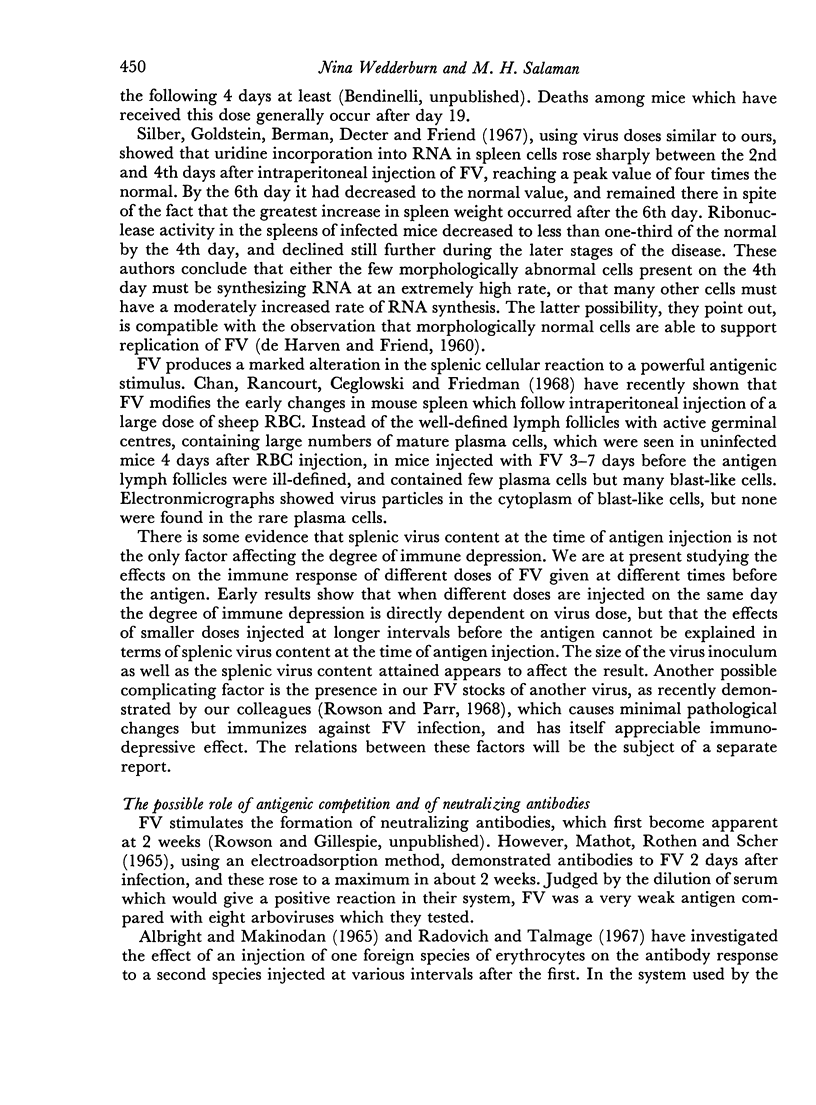
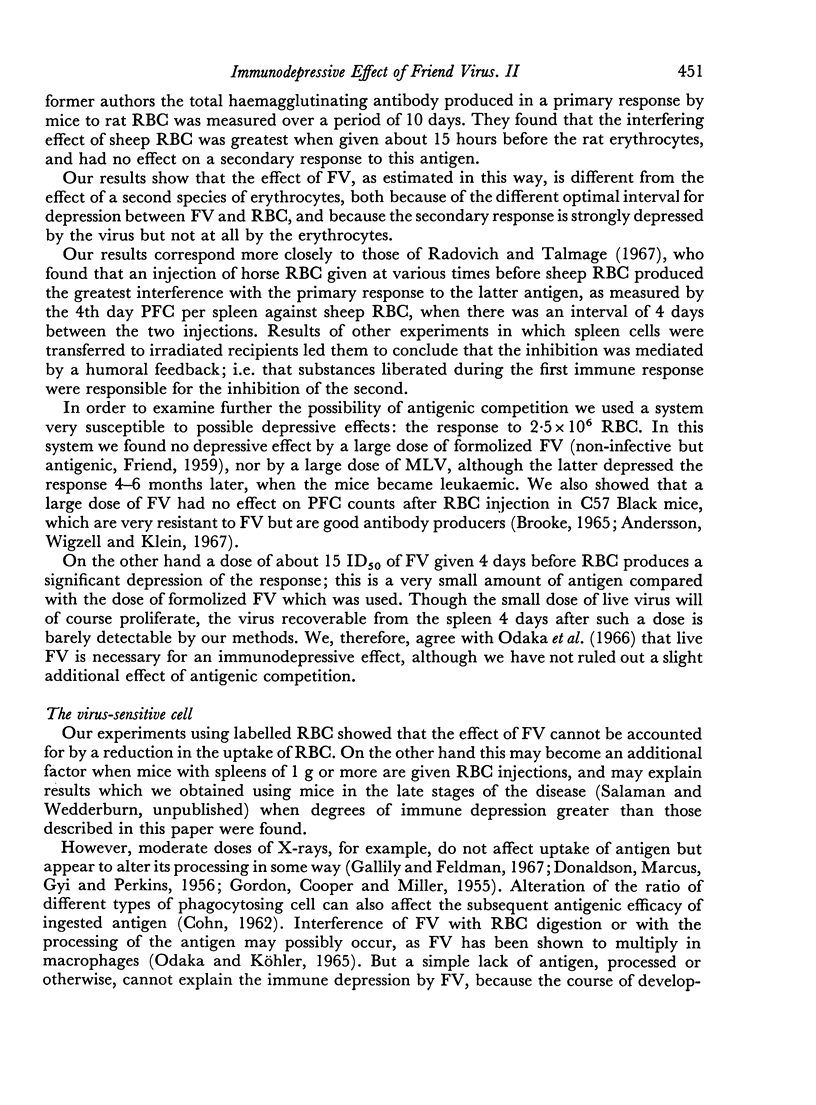
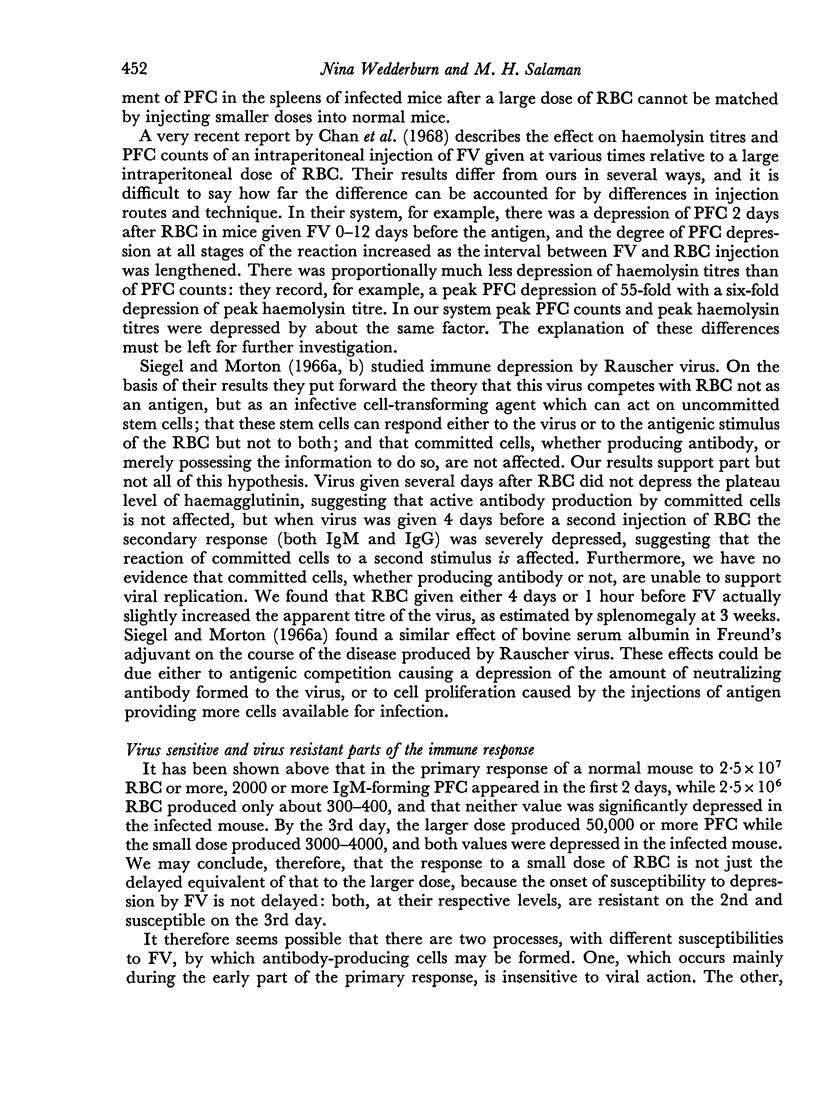
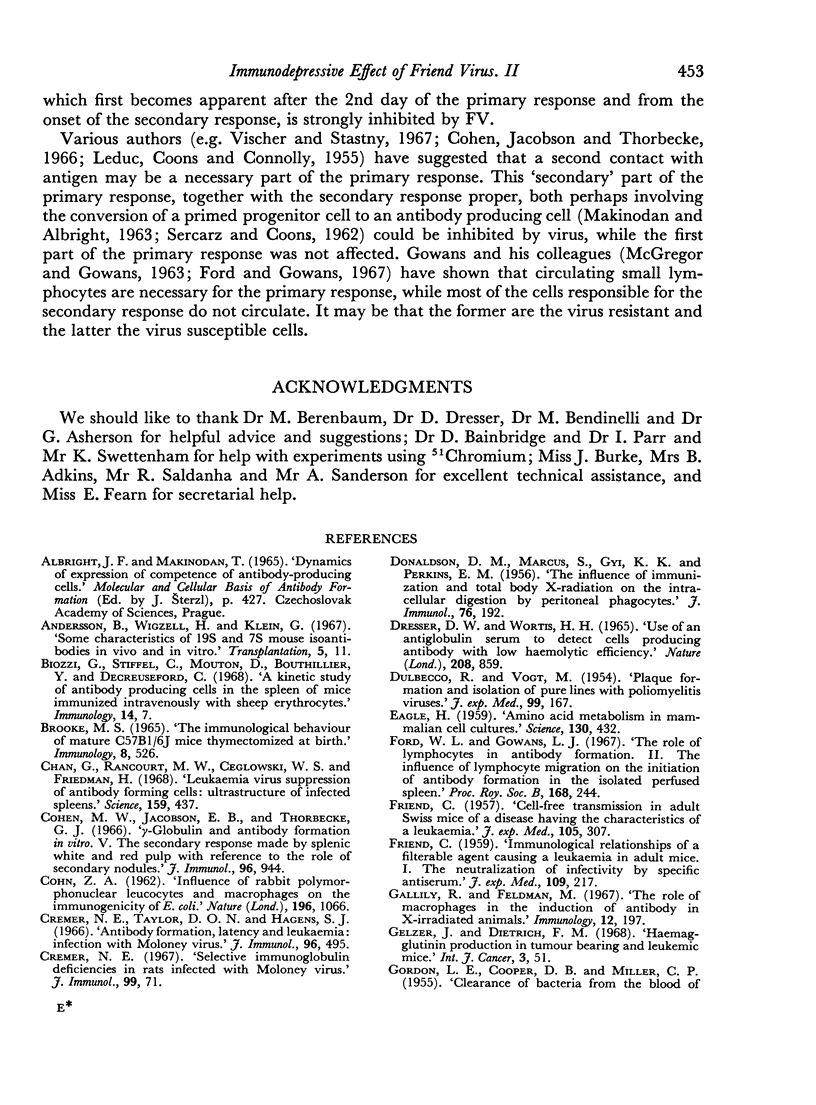
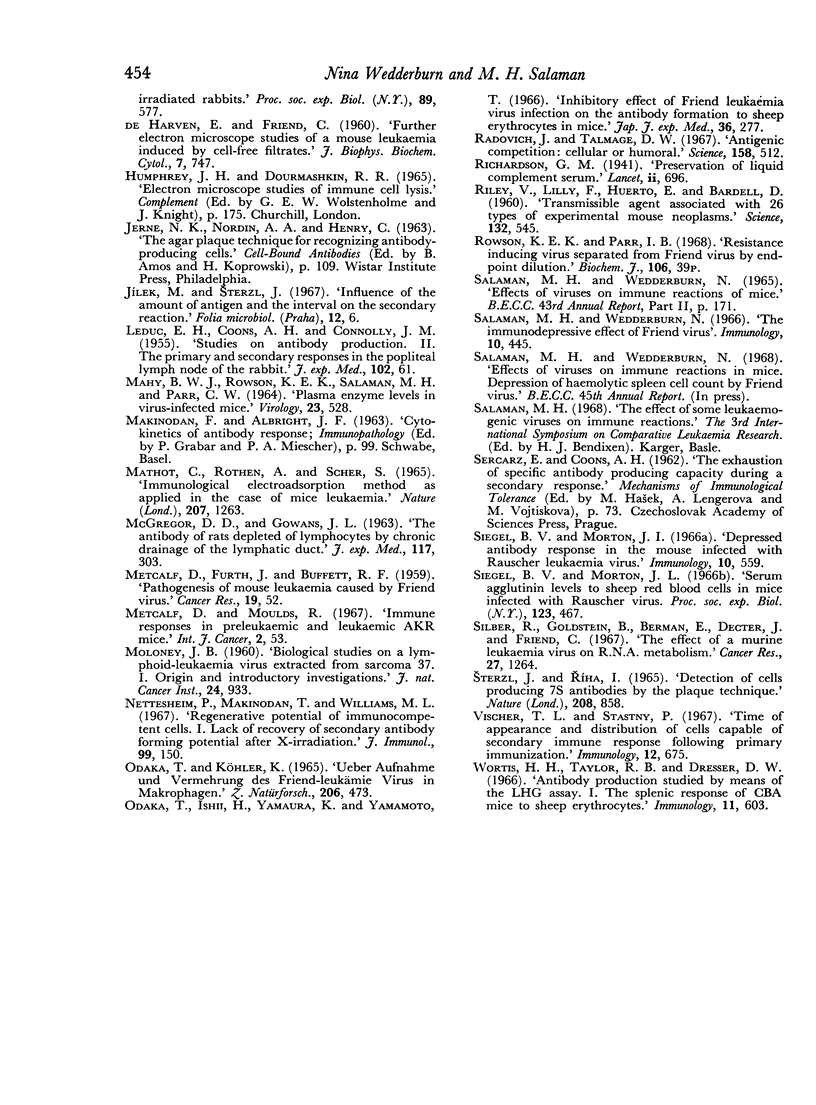
Selected References
These references are in PubMed. This may not be the complete list of references from this article.
- Biozzi G., Stiffel C., Mouton D., Bouthillier Y., Decreusefond C. A kinetic study of antibody producing cells in the spleen of mice immunized intravenously with sheep erythrocytes. Immunology. 1968 Jan;14(1):7–20. [PMC free article] [PubMed] [Google Scholar]
- Brooke M. S. The immunological behaviour of mature C57BL-6J mice thymectomized at birth. Immunology. 1965 May;8(5):526–528. [PMC free article] [PubMed] [Google Scholar]
- COHN Z. A. Influence of rabbit polymorphonuclear leucocytes and macrophages on the immunogenicity of Escherichia coli. Nature. 1962 Dec 15;196:1066–1068. doi: 10.1038/1961066a0. [DOI] [PubMed] [Google Scholar]
- Chan G., Rancourt M. W., Ceglowski W. S., Friedman H. Leukemia virus suppression of antibody-forming cells: ultrastructure of infected spleens. Science. 1968 Jan 26;159(3813):437–439. doi: 10.1126/science.159.3813.437. [DOI] [PubMed] [Google Scholar]
- Cohen M. W., Jacobson E. B., Thorbecke G. J. Gamma-globulin and antibody formation in vitro. V. The secondary response made by splenic white and red pulp with reference to the role of secondary nodules. J Immunol. 1966 Jun;96(6):944–952. [PubMed] [Google Scholar]
- Cremer N. E. Selective immunoglobulin deficiencies in rats infected with Moloney virus. J Immunol. 1967 Jul;99(1):71–81. [PubMed] [Google Scholar]
- Cremer N. E., Taylor D. O., Hagens S. J. Antibody formation, latency and leukemia: infection with Moloney virus. J Immunol. 1966 Mar;96(3):495–508. [PubMed] [Google Scholar]
- DE HARVEN E., FRIEND C. Further electron microscope studies of a mouse leukemia induced by cell-free filtrates. J Biophys Biochem Cytol. 1960 Jul;7:747–752. doi: 10.1083/jcb.7.4.747. [DOI] [PMC free article] [PubMed] [Google Scholar]
- DONALDSON D. M., MARCUS S., GYI K. K., PERKINS E. H. The influence of immunization and total body x-irradiation on intracellular digestion by peritoneal phagocytes. J Immunol. 1956 Mar;76(3):192–199. [PubMed] [Google Scholar]
- DULBECCO R., VOGT M. Plaque formation and isolation of pure lines with poliomyelitis viruses. J Exp Med. 1954 Feb;99(2):167–182. doi: 10.1084/jem.99.2.167. [DOI] [PMC free article] [PubMed] [Google Scholar]
- Dresser D. W., Wortis D. H. Use of an antiglobulin serum to detect cells producing antibody with low haemolytic efficiency. Nature. 1965 Nov 27;208(5013):859–861. doi: 10.1038/208859a0. [DOI] [PubMed] [Google Scholar]
- EAGLE H. Amino acid metabolism in mammalian cell cultures. Science. 1959 Aug 21;130(3373):432–437. doi: 10.1126/science.130.3373.432. [DOI] [PubMed] [Google Scholar]
- FRIEND C. Cell-free transmission in adult Swiss mice of a disease having the character of a leukemia. J Exp Med. 1957 Apr 1;105(4):307–318. doi: 10.1084/jem.105.4.307. [DOI] [PMC free article] [PubMed] [Google Scholar]
- FRIEND C. Immunological relationships of a filterable agent causing a leukemia in adult mice. I. The neutralization of infectivity by specific antiserum. J Exp Med. 1959 Feb 1;109(2):217–228. doi: 10.1084/jem.109.2.217. [DOI] [PMC free article] [PubMed] [Google Scholar]
- Ford W. L., Gowans J. L. The role of lymphocytes in antibody formation. II. The influence of lymphocyte migration on the initiation of antibody formation in the isolated, perfused spleen. Proc R Soc Lond B Biol Sci. 1967 Sep 12;168(1012):244–262. doi: 10.1098/rspb.1967.0064. [DOI] [PubMed] [Google Scholar]
- Gallily R., Feldman M. The role of macrophages in the induction of antibody in x-irradiated animals. Immunology. 1967 Feb;12(2):197–206. [PMC free article] [PubMed] [Google Scholar]
- Gelzer J., Dietrich F. M. Haemaglutinin production in tumour-bearing and leukaemic mice. Int J Cancer. 1968 Jan 15;3(1):51–60. doi: 10.1002/ijc.2910030108. [DOI] [PubMed] [Google Scholar]
- LEDUC E. H., COONS A. H., CONNOLLY J. M. Studies on antibody production. II. The primary and secondary responses in the popliteal lymph node of the rabbit. J Exp Med. 1955 Jul 1;102(1):61–72. doi: 10.1084/jem.102.1.61. [DOI] [PMC free article] [PubMed] [Google Scholar]
- MAHY B. W., ROWSON K. E., SALAMAN M. H. PLASMA ENZYME LEVELS IN VIRUS-INFECTED MICE. Virology. 1964 Aug;23:528–541. doi: 10.1016/0042-6822(64)90237-5. [DOI] [PubMed] [Google Scholar]
- METCALF D., FURTH J., BUFFETT R. F. Pathogenesis of mouse leukemia caused by Friend virus. Cancer Res. 1959 Jan;19(1):52–58. [PubMed] [Google Scholar]
- MOLONEY J. B. Biological studies on a lymphoid-leukemia virus extracted from sarcoma 37. I. Origin and introductory investigations. J Natl Cancer Inst. 1960 Apr;24:933–951. [PubMed] [Google Scholar]
- Mathot C., Rothen A., Scher S. Immunological electro-adsorption method as applied in the case of mice leukaemia. Nature. 1965 Sep 18;207(5003):1263–1264. doi: 10.1038/2071263a0. [DOI] [PubMed] [Google Scholar]
- Metcalf D., Moulds R. Immune responses in preleukaemic and leukaemic AKR mice. Int J Cancer. 1967 Jan 15;2(1):53–58. doi: 10.1002/ijc.2910020109. [DOI] [PubMed] [Google Scholar]
- Nettesheim P., Makinodan T., Williams M. L. Regenerative potential of immunocompetent cells. I. Lack of recovery of secondary antibody-forming potential after x-irradiation. J Immunol. 1967 Jul;99(1):150–157. [PubMed] [Google Scholar]
- Odaka T., Ishi H., Yamaura K., Yamamoto T. Inhibitory effect of Friend leukemia virus infection on the antibody formation to sheep erythrocytes in mice. Jpn J Exp Med. 1966 Jun;36(3):277–290. [PubMed] [Google Scholar]
- Radovich J., Talmage D. W. Antigenic competition: cellular or humoral. Science. 1967 Oct 27;158(3800):512–514. doi: 10.1126/science.158.3800.512. [DOI] [PubMed] [Google Scholar]
- Riley V., Lilly F., Huerto E., Bardell D. Transmissible Agent Associated with 26 Types of Experimental Mouse Neoplasms. Science. 1960 Aug 26;132(3426):545–547. doi: 10.1126/science.132.3426.545. [DOI] [PubMed] [Google Scholar]
- Siegel B. V., Morton J. I. Depressed antibody response in the mouse infected with Rauscher leukaemia virus. Immunology. 1966 Jun;10(6):559–562. [PMC free article] [PubMed] [Google Scholar]
- Siegel B. V., Morton J. I. Serum agglutinin levels to sheep red blood cells in mice infected with Rauscher virus. Proc Soc Exp Biol Med. 1966 Nov;123(2):467–470. doi: 10.3181/00379727-123-31516. [DOI] [PubMed] [Google Scholar]
- Silber R., Goldstein B., Berman E., Decter J., Friend C. The effect of a murine leukemia virus on RNA metabolism. Cancer Res. 1967 Jul;27(7):1264–1269. [PubMed] [Google Scholar]
- Sterzl J., Ríha I. Detection of cells producing 7S antibodies by the plaque technique. Nature. 1965 Nov 27;208(5013):858–859. doi: 10.1038/208858a0. [DOI] [PubMed] [Google Scholar]
- Vischer T. L., Stastny P. Time of appearance and distribution of cells capable of secondary immune response following primary immunization. Immunology. 1967 Jun;12(6):675–687. [PMC free article] [PubMed] [Google Scholar]
- Wortis H. H., Taylor R. B., Dresser D. W. Antibody production studied by means of the LHG assay. I. The splenic response of CBA mice to sheep erythrocytes. Immunology. 1966 Dec;11(6):603–616. [PMC free article] [PubMed] [Google Scholar]


